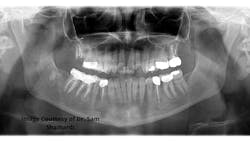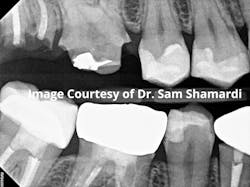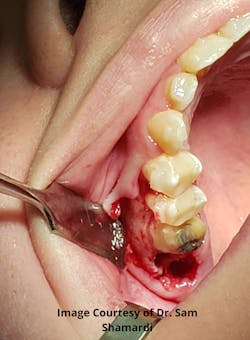Clinical Collaboration: Crown lengthening
This month I had the privilege of working with periodontist Dr. Sam Shamardi.
Patient procedure completed: Extraction of residual root tips from fracture of tooth no. 2 and crown lengthening for no. 3.
What is crown lengthening?
A dental crown lengthening procedure adjusts the gum and bone level to expose more of the tooth so it can be restored.
When is crown lengthening advised?
Crown lengthening is advised in this specific case because the decay was so large that the natural tooth structure left behind is not the recommended amount to properly hold the crown. At least 3 to 4 mm of sound root structure must be exposed below the most apical extent of the proposed restoration. Crown lengthening can also be used to remove excess gingiva for "gummy" smiles or provide better esthetics, especially around anterior veneers or crowns.
Dr. Shamardi advised the patient an implant can be considered no sooner than 4 months after the extraction site has healed. He believed the patient would heal well between 3 to 7 days depending on the trauma. He advised the patient to wait 8 to 10 weeks minimum for the crown lengthening to heal before placing a porcelain or gold crown. The ideal waiting time, however, is 3 months.
The patient's temporary crown was placed with as little cement as possible to prevent the cement from oozing into the extraction and surgery sites, as it would compromise the healing. The patient reported no pain the following day and is healing well.
Clinician Q&A
Amber Auger: Dr. Shamardi, what is recommend for home care during this time of healing for the patient?
Dr. Shamardi: The most important aspect of homecare is leaving the area alone for a minimum of 10 to 14 days. This means no brushing, flossing, or aggressive Waterpik use or interdental brushing in the area. We advise patients to chew food on the opposite side and avoid sharp foods such as popcorn, chips, and nuts for the first week. We do not want to disturb the tissue while it is healing or pull on the sutures. The patient is encouraged to maintain all normal home care practices for the other areas in the mouth, just not in that specific surgical site.
We recommend the use of Peridex rinse in this period to keep the area clean; only a small amount is necessary and exposure to the site is the key. For patients concerned about staining, a cotton swab can be used to gently swab the surgical site. Salt rinses or over-the-counter rinses may also be used, but many will burn and irritate the site and are not as antibacterial as Peridex.
After the 10 to 14 day period, the patient may begin to gently brush and floss again. It's important to understand that there may be initial bleeding due to inflammation, which is OK, and that will subside after a few days. Chewing on the area will also be a gradual process that can resumed at this time as well.
Please keep in mind, due to the newly exposed tooth structure, some patients may experience cold sensitivity; this is normal and will improve over the healing. Eventually, once the final crown is placed, the exposure will be covered.
For discomfort, we recommend anti-inflammatory medication such Advil or Aleve. If the patient cannot take this due to medical history and/or stomach issues, Tylenol may also be used but won't be quite as effective as it is not anti-inflammatory. Additionally, if the procedure area was large, the patient has a history of swelling easily and/or the procedure was traumatic, we sometimes prescribe a Medrol dose pack steroid to further help reduce overall swelling and pressure in the area. This all will need to be cleared via their respective medical history. Antibiotics are not given for this procedure, unless during the healing time an infection develops. However, this is not very common.
Amber Auger: When it comes to crown lengthening, how can the dental hygienist best educate the patient to keep it clean?
Dr. Shamardi: The best advice is to remind them to avoid the area at the start! Afterward, they can review the proper use of flossing, gentle brushing (so as to not aggressively brush the gingiva), and use of interdental brushes and/or Waterpik. The most important aspect is the timing itself; begin too soon and you risk affecting proper healing. Start too late and you may have an area that is highly inflamed and full of plaque with a higher chance of delayed or poor healing.
Amber Auger: Anything else?
Dr. Shamardi: Crown lengthening is a significant procedure that can help save the continued function of a tooth. It can help provide a great alternative to tooth replacement, but careful treatment planning and considerations must be taken during the consultation phase to avoid causing unwanted iatrogenic damage to the area (furcation creation, mobility, etc). When planned and executed properly, it can positively transform dental treatment!
Amber Auger, MPH, RDH, is a practicing dental hygienist and clinical innovations implementation specialist. With 14 years of experience in the dental industry, Auger works with practices to provide customized protocols, to refocus on the patient experience, and to utilize systemic approaches to periodontal therapy. She is a regular contributor to RDH magazine, a featured author for DentistryIQ, and host of #AskAmberRDH. Auger also provides preventive services abroad yearly and is always willing to have dental professionals join her team. She can be reached at [email protected].
About the Author

Amber Auger, MPH, RDH
Amber Auger, MPH, RDH, is an international lecturer, 2019 Sunstar/RDH Award of Distinction recipient, and creator of Thrive in the OP and the certified Functional RDH. With more than 24 years in the dental field and practicing hygiene since 2010, Amber empowers professionals through on-demand courses and coaching. She specializes in root-cause soft tissue management, practical protocols, and career development, inspiring clinicians to enhance patient care and achieve career satisfaction. Reach Amber at [email protected].


